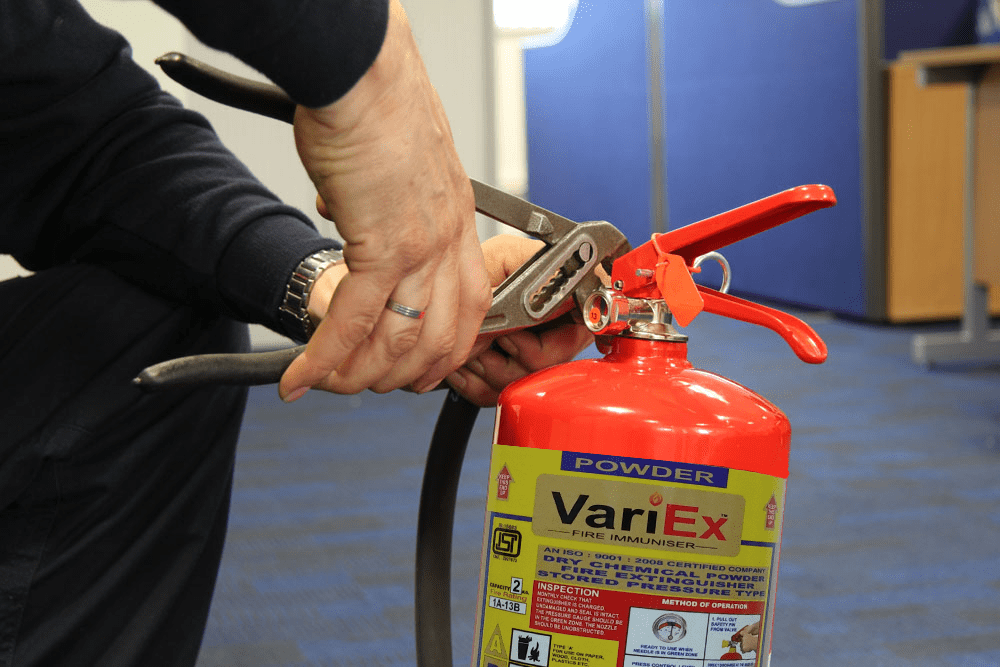![]()
Fire Immuniser
+91-7829629111
Email: info@variex.in
Varistor Technologies Pvt. Ltd.
Block-1, First Floor, Ardente Office One, Hoodi Circle, ITPL Main Road, Bengaluru, Karnataka 560048, IN
What'S Inside A Fire Extinguishers
Fire extinguishers are essential safety devices designed to control or extinguish small fires, helping to prevent the spread of fire and protect lives and property. Understanding what's inside a fire extinguisher is crucial for effective usage and maintenance. Typically, fire extinguishers contain a combination of components that work together to suppress fires effectively. Here's a breakdown of what you'll find inside a typical fire extinguisher:
- Cylinder: Fire extinguisher cylinders are manufactured to withstand high pressure to contain the extinguishing agent. They are rigorously tested to ensure durability and safety. Steel cylinders are commonly used for higher pressure applications, while aluminum cylinders are preferred for their lightweight properties, making them easier to handle.
- Pressure Gauge: The pressure gauge indicates the status of the extinguisher's charge. It typically has a green zone to signify adequate pressure and a red zone to indicate low pressure. Regular checks of the pressure gauge are essential to ensure that the extinguisher is ready for use at all times.
Extinguishing Agent:
- Water: Water extinguishers are effective for cooling and extinguishing Class A fires by reducing the temperature of the fuel below its ignition point.
- Dry Chemicals: Dry chemical extinguishers work by interrupting the chemical reaction of the fire, forming a barrier between the fuel and the oxygen. They are versatile and can be used on various types of fires.
- Carbon Dioxide (CO2): CO2 extinguishers displace oxygen, suffocating the fire. They leave no residue, making them suitable for use in areas where cleanup is a concern, such as electrical equipment.
- Foam: Foam extinguishers smother the fire by forming a film that suppresses the release of flammable vapors and cools the fuel surface.
- Wet Chemical: Wet chemical extinguishers react with cooking oils and fats to create a soapy film that suppresses the fire and prevents re-ignition.
- Propellant: In some fire extinguishers, a propellant gas, such as nitrogen, is used to expel the extinguishing agent from the cylinder rapidly when the extinguisher is activated. The propellant is stored separately from the extinguishing agent within the cylinder.
- Internal Components: Components such as dip tubes or siphon tubes are designed to ensure that the extinguishing agent is dispensed effectively when the extinguisher is operated. These components help maintain the integrity of the extinguisher's contents and ensure proper discharge.
- Valve Assembly: The valve assembly controls the flow of the extinguishing agent and is activated when the handle or trigger is pressed. It is essential for regulating the discharge rate and ensuring that the extinguisher operates safely and effectively.
- Safety Pin and Seal: The safety pin or seal prevents accidental discharge of the extinguisher. It must be removed before operation, typically by pulling a pin or breaking a seal, to allow the extinguisher to be activated.
Understanding the intricate details of each component inside a fire extinguisher is crucial for proper maintenance, inspection, and usage. Additionally, knowing the capabilities and limitations of different types of fire extinguishers helps ensure that they are deployed effectively in emergency situations. Regular training in fire safety and extinguisher operation is essential for all individuals who may encounter fire hazards.
Frequently Asked Questions
A fire extinguisher is a portable device used to control or extinguish small fires by releasing an extinguishing agent onto the fire.
Fire extinguishers work by expelling an extinguishing agent onto the fire, which disrupts the fire triangle (fuel, heat, oxygen) and suppresses the flames.
There are several types of fire extinguishers designed to tackle different classes of fires:
- Class A: Ordinary combustibles (wood, paper, cloth)
- Class B: Flammable liquids (gasoline, oil, grease)
- Class C: Electrical fires
- Class D: Combustible metals
- Class K: Cooking oils and fats
The selection of a fire extinguisher depends on the specific fire hazards present. Consider the classes of fires that could occur and choose extinguishers labeled with the appropriate class ratings.
Fire extinguishers should be visually inspected monthly to ensure they are in the correct location, undamaged, and properly charged. Additionally, they should undergo a professional inspection annually and a hydrostatic test every few years, as recommended by local regulations.
Final Say
We at VariEx.in or Variexonline.com have mastered the art of designing, installing, inspecting, and fixing automatic sprinkler systems with the help of our in-house team, which is capable of delivering the fire sprinkler services you need, whether large or small and at affordable cost.
To schedule a fire sprinkler installation, or you think our services could benefit your commercial property, contact us online or give us a call at, 7829629111



